Effective Solutions to a Slow Bathtub Drain
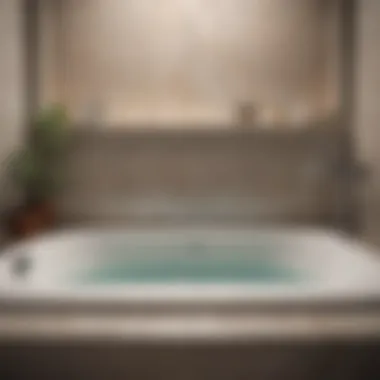
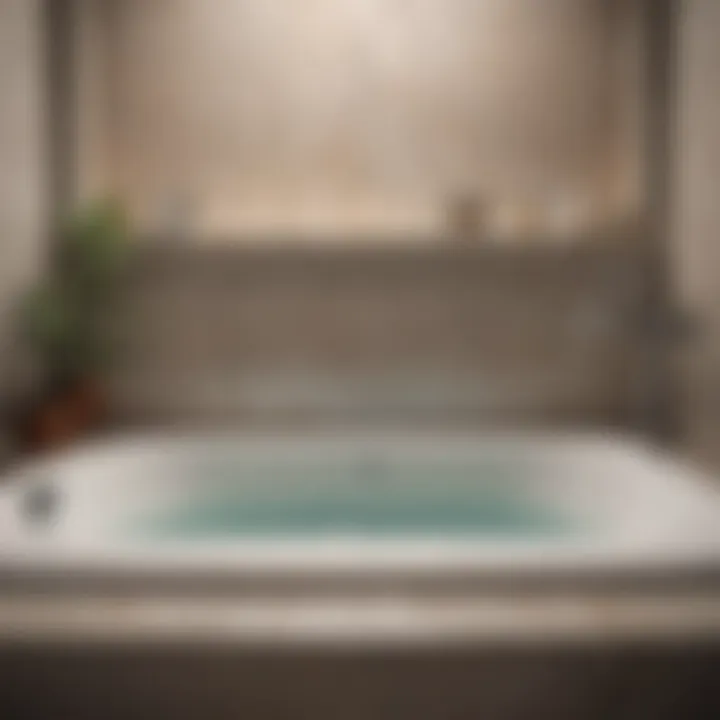
Intro
A slow bathtub drain can significantly hinder your bathing experience. Numerous factors contribute to this annoyance, including hair buildup, soap scum, and even hard water deposits. Frequently, homeowners overlook these minor issues until they escalate into more serious plumbing problems. Understanding how to effectively address a slow drain is crucial not only to maintain comfort but also to prevent potential water damage that may arise from persistent clogging.
This article explores both simple remedies and advanced techniques for resolving slow drainage issues in bathtubs. By addressing the root causes and implementing practical solutions, you can restore your bathtub's functionality without the need for professional assistance. The guide provides thorough instructions, necessary tools, and preventive measures to keep your drainage system running smoothly.
Preface to Slow Bathtub Drains
The issue of a slow bathtub drain is not merely a nuisance; it can significantly impact daily routines and overall hygiene. Understanding how to address this problem is essential for every homeowner or renter. A clogged drain can lead to water buildup, which creates unsanitary conditions and may promote mold growth. Furthermore, resolving a slow drain promptly can save both time and money.
This article delves into various aspects of slow bathtub drains, aimed at equipping readers with effective techniques and preventive measures. By addressing this common plumbing challenge, individuals can ensure a hassle-free bathing experience while also prolonging the life of their plumbing systems.
Understanding the Problem
Slow drainage often stems from various minor issues that accumulate over time. Hair, soap residue, and mineral deposits can obstruct the flow of water, creating frustration and potential plumbing problems. Identifying the root cause is crucial in determining the best course of action. If ignored, minor blockages can evolve into more severe clogs, requiring professional intervention. Recognizing the nature of the problem involves a proactive approach. Regular checks on bathroom fixtures can mitigate the likelihood of slow drains and foster a more efficient plumbing system.
Common Symptoms
Noticing the early signs of a slow bathtub drain can make a significant difference. Common symptoms include:
- Water pooling: Water does not exit quickly and gathers in the tub after use.
- Unpleasant odors: Stagnant water can generate odors that permeate the bathroom.
- Gurgling sounds: A gurgling noise can indicate trapped air and potential blockages in the pipes.
- Frequent re-clogs: A recurring need for clearing the drain may signal underlying issues.
Recognizing these symptoms early can lead to timely interventions that preserve the integrity of your drainage system.
Causes of Slow Drainage
Understanding the causes of slow drainage is crucial for effectively addressing the issue in your bathtub. Each impede that affects drainage can be traced back to specific factors, with the right identification leading to more efficient solutions. By understanding these causes, homeowners can better maintain their plumbing systems and avoid future clogs. This section explores various elements contributing to slow bathtub drains, offering insight into effective preventative measures.
Hair Accumulation
One of the primary culprits behind slow bathtub drains is hair accumulation. Hair, especially long hair, is prone to getting trapped in the drain over time. As the hair weaves together with soap and other debris, it forms clumps that can significantly restrict water flow. To address this, it is advisable to install drain covers designed to catch hair before it enters the plumbing system. Regular cleaning of these covers can effectively prevent buildup.
Hair accumulation is particularly common in households with multiple occupants or young children. You might notice slow drainage after baths or showers. This not only causes inconvenience but can also lead to further plumbing issues if not addressed promptly.
Soap Scum Build-Up
Soap scum build-up is another major cause of slow drainage in bathtubs. The residue left behind from soap mixes with minerals in the water, creating a hard, sticky film. Over time, this layer thickens and can create a barrier that obstructs flow. This is especially true for bath products that contain moisturizing agents; they tend to leave more residue than traditional soaps.
To combat soap scum, periodic cleaning with appropriate bathroom cleaners is essential. Using a mixture of vinegar and baking soda can help dissolve soap scum effectively. Maintaining a clean environment in the tub area minimizes the chances of buildup.
Mineral Deposits
Mineral deposits, often referred to as limescale, can also contribute to slow drainage. Hard water contains high levels of calcium and magnesium, which can accumulate on the insides of pipes and bathtubs. These deposits can restrict water flow, leading to slower draining times. The presence of mineral deposits is often most noticeable in regions with hard water.
Regular descaling treatments can help mitigate this issue. Products specifically designed for mineral buildup can be used to maintain optimal flow and ensure your drainage system functions efficiently. Garages or basements also need consideration, as residue might accumulate in pipes leading to the bathtub.
Foreign Objects
Interestingly, foreign objects can create blockages that cause slow drainage. Small items like toys, bits of cloth, or even loose change can accidentally fall into the drain. These objects tend to trap hair and soap effectively, contributing to clogs. In cases where foreign objects are suspected, manual inspection or the use of plumbing tools may be needed to remove these impediments.
It is advisable to educate family members about preventing items from falling into the drainage system. Regular monitoring can help catch any such occurrences early.
Preparation for Drain Cleaning
Preparing for drain cleaning is essential to ensure a smooth process and effective results. Understanding what you need to get started can save time and prevent complications. This stage also allows you to assess the situation, ensuring you have everything required before attempting any cleaning methods. Appropriate preparation reduces the risk of causing damage and increases the likelihood of restoring the drain's functionality.
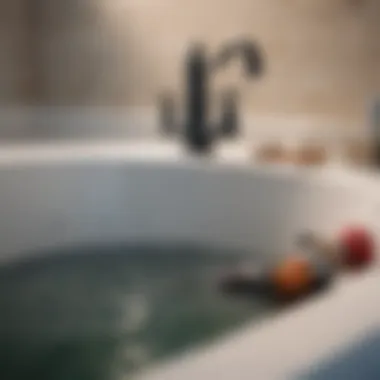
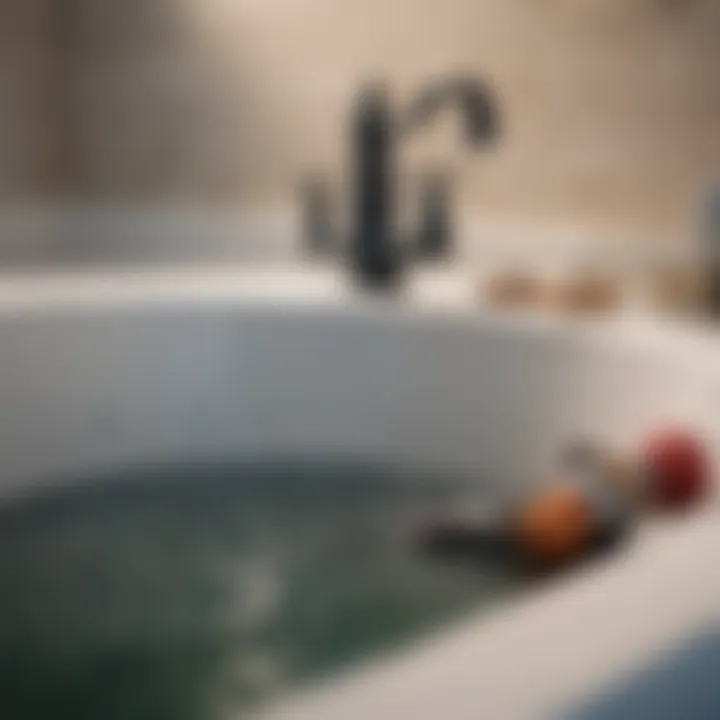
Essential Tools Required
Getting the right tools is a key part of preparation. Each tool serves a specific purpose and helps tackle different kinds of clogs.
Plumber's Snake
A plumber's snake is crucial when dealing with deep clogs. It consists of a flexible metal coil that can reach into pipes. The key characteristic of a plumber’s snake is its length; it can extend into many feet of drainage systems. This makes it a beneficial tool in many situations.
One unique feature of this tool is its rotating end that breaks apart clogs. However, using it requires some skill to navigate bends in the pipe effectively. A disadvantage can be that it may not always reach the entirety of severe clogs, especially if they are very far down the system.
Drain Auger
The drain auger is another excellent tool known for its effectiveness on stubborn blockages. It is similar to a plumber's snake but often has a corkscrew tip designed to grab onto debris. This tool’s key characteristic is its ability to drill through tough clogs. It is a popular choice for homeowners who frequently deal with slow drains.
The advantage of a drain auger is its efficiency in reaching far blockages. However, it may require more strength, as it can involve considerable manual effort. Some users find it challenging to manage, especially in tight spaces.
Bucket
A bucket is often overlooked, yet it plays a vital role in collecting water and debris during the cleaning process. The key characteristic of a bucket is its size and stability; it can hold a significant amount and is easily portable. It is also beneficial because it prevents excess water from creating a mess in your bathroom.
Uniquely, a bucket can be used to mix DIY cleaning solutions or ridge solutions before pouring them into the drain. One disadvantage could be that a small bucket may not hold enough, necessitating multiple trips.
Gloves
Wearing gloves is a basic yet critical precaution. The primary aspect of gloves is to protect your hands from harsh chemicals or sharp objects you might encounter. Their key characteristic is the material, which should be strong and resistant to chemicals. Using gloves is crucial for safety in this process.
The unique feature of gloves is that they offer grip while also acting as a barrier. One disadvantage might be their limitations in dexterity, making delicate tasks harder. However, the protection they provide far outweighs this concern.
Safety Precautions
Ensuring personal safety during drain cleaning cannot be emphasized enough. Taking the right precautions protects both you and your plumbing system.
Protective Gear
Protective gear enhances safety while conducting drain cleaning. This gear often includes goggles and masks to shield against splashes. The essential feature is that it prevents exposure to harmful substances. It is a beneficial choice for anyone engaging in this task, particularly for individuals sensitive to strong smells or chemicals.
The unique aspect of this protective gear is its availability in various forms, tailored to different environments. A potential disadvantage could be discomfort while wearing. However, prioritizing safety should make this a minimal concern.
Ventilation
Ventilation is crucial when using any chemicals or undertaking significant cleaning tasks. It ensures that any harmful fumes dissipate quickly. The key characteristic of good ventilation is air circulation within the space, making it essential for maintaining a safe working environment.
Ventilation helps reduce risks associated with inhaling fumes or odors. Unique features may include placing fans or opening windows. However, it can be challenging to achieve adequate airflow in some spaces. Overall, proper ventilation is necessary for a safe and effective cleaning process.
Basic Techniques for Clearing a Slow Drain
Addressing a slow bathtub drain requires understanding effective methods to restore proper flow. Basic techniques often serve as the first line of defense before needing to resort to more advanced solutions. The benefits of these techniques lie in their simplicity and accessibility. Most homeowners have the tools required for these methods, and they can be executed without professional help. Furthermore, by employing these basic methods, individuals can often avert the need for costly plumbing services.
Hot Water Flush
A hot water flush is one of the simplest yet effective methods to clear a slow drain. When hot water is poured down the drain, it can help dissolve soap scum and grease that may be causing the clog. This method is especially useful when addressing slow drains resulting from built-up residues.
To perform a hot water flush:
- Boil a kettle of water or use a large pot to heat water on the stove.
- Carefully pour the hot water directly into the drain in stages. This approach provides time for the water to work on the blockage.
- Repeat as necessary, ensuring that piping is safe for hot water exposure.
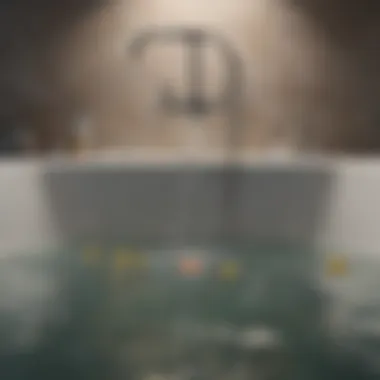
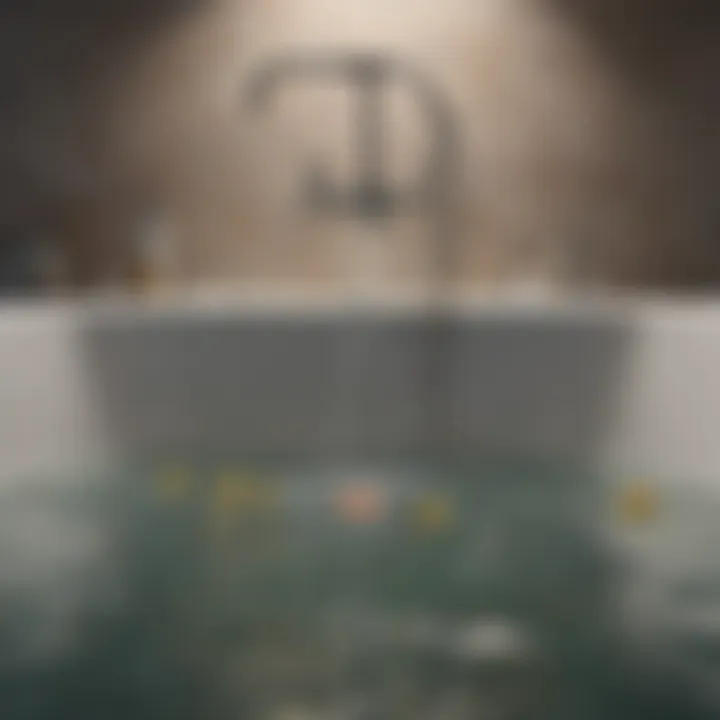
It's essential to note that while hot water can assist in clearing minor clogs, it may not be suitable for all drainage types. For instance, older plumbing systems may not handle extreme temperatures well, so caution is advisable.
Baking Soda and Vinegar Method
The combination of baking soda and vinegar is a well-known natural remedy for clearing drains. This method employs a chemical reaction that can help break down build-up in the pipes.
Here is how to effectively use this method:
- Measure half a cup of baking soda and pour it into the drain.
- Follow with half a cup of vinegar. The mixture will start to fizz, indicating a reaction taking place.
- Cover the drain with a plug or cloth to allow the reaction to work. Wait for about 30 minutes.
- Flush the drain with hot water.
Using this method once a month can help maintain clear drains and prevent slow drainage problems from occurring.
Manual Removal of Debris
If previous methods do not resolve the issue, manually removing debris might be necessary. A physical blockage may require direct intervention to restore flow. This could involve removing the drain cover and accessing the pipes directly.
Steps for manual removal include:
- Gather tools like a drain snake or a simple pair of gloves. A flashlight might be helpful for visibility.
- Remove any visible hair or debris around the drain opening. This can often be done with your hands or a tool.
- Insert a drain snake, if available, into the pipe. Gently twist and push to dislodge any remaining blockages.
- Run water to check if proper drainage has resumed before sealing the drain cover again.
Employing these basic techniques can significantly help in clearing a slow bathtub drain. Regular use may also prevent future clogs, ensuring the bathtub functions smoothly over time.
Advanced Methods for Persistent Clogs
When it comes to dealing with slow bathtub drains, sometimes standard home remedies do not suffice. For those stubborn clogs that refuse to budge, advanced methods become necessary. These techniques not only address the immediate issue but also help in maintaining long-term drainage health. Understanding these methods is crucial because they can save time, effort, and potentially expensive plumbing repairs.
Using tools such as a plumber's snake, drain auger, or hydro jetting can clear deeper, more complicated clogs. Each of these methods has its advantages and can be selected based on the severity of the blockage, the type of materials involved, and the specific plumbing system in place. Let's delve deeper into these advanced techniques.
Using a Plumber's Snake
A plumber's snake, also known as a drain snake, is a flexible tool that can reach deep into pipes. This method is especially effective for clogs caused by hair and foreign objects that are lodged in the drain.
To use a plumber's snake:
- Insert the end of the snake into the drain opening.
- Turn the handle clockwise to feed the snake into the pipe.
- When encountering resistance, continue to twist and push gently.
- Once the obstruction is cleared, carefully withdraw the snake, along with any debris it has collected.
One of the benefits of using a plumber's snake is its ability to effectively clear clogs without the use of harsh chemicals. It is a relatively safe and economical tool, often yielding great results with patience and persistence.
Drain Auger Techniques
A drain auger, similar to a plumber's snake, is designed for more challenging blocks. A drain auger has a motorized mechanism, making it easier to navigate tough clogs. This method is ideal for addressing issues in larger pipes or where heavy debris has built up over time.
To use a drain auger:
- Set the auger to the appropriate setting for the size of pipe you are dealing with.
- Insert the auger head into the drain.
- Activate the motor, allowing the auger to cut through the blockage.
- Pull the auger out carefully, inspecting for any debris.
Drain augers can be rented for a modest fee from most hardware stores. They are powerful tools, capable of reaching deeper into pipes and clearing out significant build-up.
Hydro Jetting
Hydro jetting is the most effective technique for clearing persistent clogs, particularly those caused by extensive deposits or tree roots in the drain lines. It uses high-pressure water streams to blast through clogs and clean the interior surfaces of pipes.
Key considerations for hydro jetting include:
- Cost: This method is generally more expensive than the others but is often worth the investment for severe issues.
- Expertise: Employing a professional service is recommended, as the high-pressure water can damage older or fragile pipes.
- Effectiveness: Hydro jetting not only clears clogs but also prevents future build-up by thoroughly cleaning the pipes.


Preventative Measures
Preventative measures are essential for maintaining a smoothly functioning bathtub drain. They help to reduce the chances of clogs, extend the lifespan of the plumbing, and ultimately save time and money on future repairs. Understanding these methods allows homeowners to take proactive steps against debris accumulation and other problems that can slow water drainage.
This section discusses two critical elements of preventative care: regular maintenance tips and the effective use of drain screens. Each of these methods serves as a barrier against the common issues that lead to slow drains.
Regular Maintenance Tips
Consistent upkeep is necessary to prevent buildup in your bathtub drain. Here are some key maintenance practices:
- Flush the Drain Regularly: At least once a month, pour boiling water down the drain to help dissolve minor grease or soap scum.
- Use Natural Cleaners: Vinegar and baking soda can be good non-toxic options to clean drains. Pour half a cup of each into the drain, let it sit for 30 minutes, and then flush with hot water.
- Conduct Inspections: Regularly check the visible parts of the drain for signs of clogging or corrosion. Clearing hair and debris when observed can prevent a bigger problem later.
- Limit Use of Harsh Chemicals: While chemical drain cleaners can provide quick fixes, they often cause more harm than good. They can erode pipes over time and create larger plumbing issues.
Following these routine measures helps to ensure that small problems do not escalate into significant clogs. A little bit of effort can go a long way in maintaining optimal function in your bathtub.
Using Drain Screens
Installing drain screens is an effective strategy for preventing foreign objects and debris from entering the drainage system. They act as filters, capturing hair, soap residue, and other materials. Here are considerations regarding their use:
- Choose the Right Size: Ensure the screen fits snugly over the drain opening to maximize its efficiency. A loose screen can allow debris to slip through.
- Regular Cleaning: Make it a habit to remove hair and debris from the screen at least once a week. This prevents buildup that could lead to slow drainage.
- Material Matters: Opt for screens made from durable materials that resist rust and corrosion, like stainless steel or heavy-duty plastic.
Using drain screens can significantly reduce the frequency of necessary unclogging interventions.
Incorporating these preventative measures into your routine will help maintain a clear bathtub drain. Being proactive is always more effective than having to react to a problem after it has already developed. By understanding and applying these practices, homeowners can enjoy a smooth draining experience and protect their plumbing systems over the long term.
When to Call a Professional
When dealing with a slow bathtub drain, many homeowners may successfully utilize basic methods to tackle the issue. However, there are crucial moments when engaging a professional plumber becomes necessary. Understanding these instances can save time, money, and further complications.
Identifying when to seek expert help requires awareness of the signs and the potential severity of the problem. Small issues can often be resolved with easy fixes such as hot water flushes or baking soda and vinegar. Still, severe conditions may escalate beyond the scope of DIY solutions. Engage a professional if you notice that repeated attempts to clear the drain fail. This could indicate a blockage deep within the plumbing system or issues with the sewer line.
One benefit of calling a plumber is access to advanced tools that are not commonly available to homeowners. Techniques such as hydro jetting or specialized drain augers can tackle stubborn clogs effectively. Professionals also bring expertise that can identify underlying plumbing problems that might not be immediately apparent. This can prevent minor issues from becoming significant repairs later.
Consider the potential consequences of delaying professional intervention. A slow drain can lead to water damage, mold growth, and more extensive plumbing repairs, which are often much more costly than an initial service call.
Identifying Severe Clogs
Severe clogs exhibit distinct symptoms that help in recognizing the need for professional help. If the bathtub drain continues to back up despite repeated attempts at clearing it, it is a sign of a significant problem, possibly affecting the main sewer line. Other indicators include gurgling sounds in the drain, multiple fixtures draining slowly, and foul odors emerging from drains. These suggest that blockages are more than just a simple formation of debris.
Additionally, persistent slow drainage may lead to standing water in the tub after bathing. This could reflect deeper issues within the plumbing system. If water pressure changes noticeably or if water levels rise in nearby fixtures when the bathtub drains, immediate professional assistance should be sought. Ignoring these signs can result in greater damage over time.
Understanding Plumbing Issues
Some plumbing issues are complicated enough to necessitate expertise. Many homeowners lack the deep knowledge of plumbing systems to properly diagnose these problems. For instance, issues like damaged pipes, tree root intrusion into sewer lines, or venting issues could cause significant drainage problems.
Water damage from plumbing issues can lead to other risks within your home, such as mold or structural integrity concerns. Professional plumbers can assess the entire plumbing layout, offering solutions that are often missed in a DIY approach.
The complexity of plumbing systems means that what seems like a simple clog may have deeper implications. Engaging a professional provides you with peace of mind, knowing that your plumbing is assessed comprehensively. An expert will not only fix the immediate problem but will also often provide recommendations for preventive measures.
"Preventive maintenance is key to prolonging the life of your plumbing and minimizing future issues."
In summary, knowing when to call a professional can mitigate risk, reduce costs in the long run, and ensure the safety and functionality of your home plumbing system.
End
The conclusion of this article serves as a pivotal summary, encapsulating the essential insights shared throughout the guide on clearing a slow bathtub drain. It offers a moment to reflect on the significance of understanding the causes of slow drainage, employing practical solutions, and maintaining forward-thinking habits to prevent future issues.
Addressing a slow bathtub drain is not merely a matter of convenience; it is integral to ensuring the overall hygiene and functionality of your bathroom. Regular awareness of potential causes, such as hair accumulation or soap scum build-up, enables proactive measures. This understanding is vital for parents who may deal with frequent clog issues from their children.
The techniques discussed in earlier sections offer tangible benefits. Simple home remedies like hot water flushes or a baking soda and vinegar combination can often restore flow without significant effort or expense. These inexpensive methods allow individuals to retain agency over household maintenance, potentially avoiding costly plumber visits. However, advanced methods like hydro jetting may eventually be necessary for persistent troubles, emphasizing the importance of knowing when to escalate the situation to professionals.
Ultimately, this article underscores the value of knowledge in home maintenance. With the right tools and information at hand, keeping a bathtub drain clear becomes a manageable task.
"An ounce of prevention is worth a pound of cure."
This adage rings true in the context of drain care. Maintaining prevention habits, such as using drain screens and conducting regular inspections, can save time and money in the long run. By following the guidance provided, readers not only troubleshoot current problems but also cultivate a sustainable, clog-free environment in their homes.



